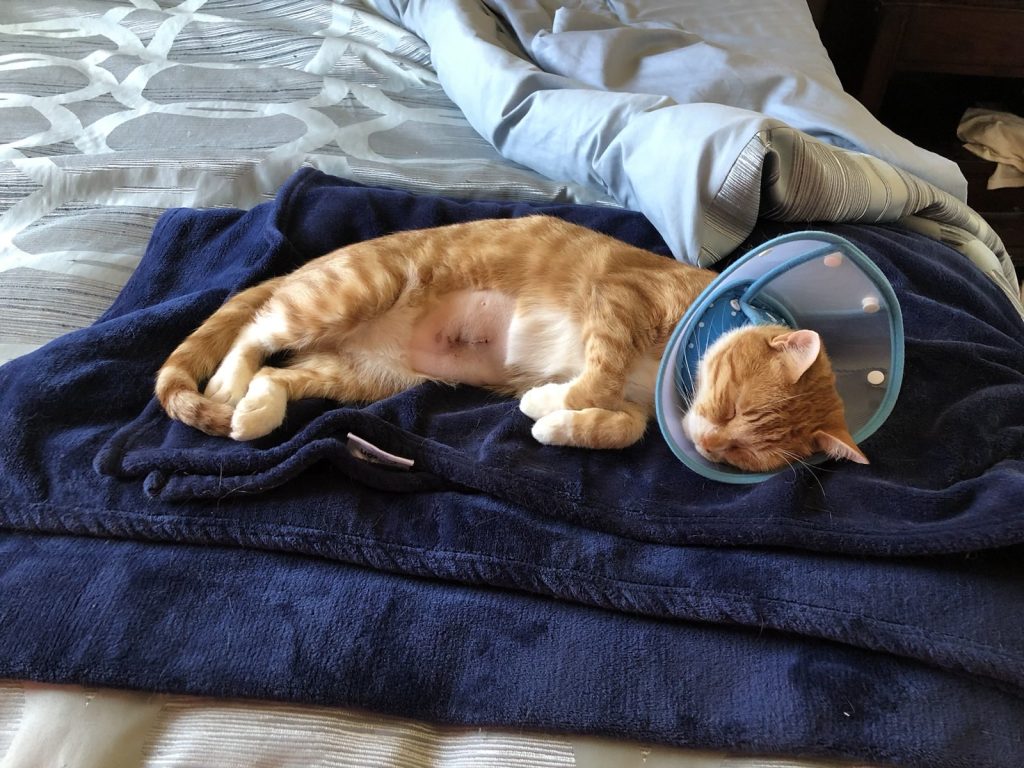Stem Cell Therapy for Cats: Kai’s story.
Stem cell therapy represents a promising frontier in veterinary medicine, offering hope for treating conditions that affect our feline friends. Our journey into the world of innovative veterinary treatments began with Kai, a charismatic orange tabby we adopted from a cat café in San Diego. Kai was no ordinary cat; he possessed a larger-than-life personality with a single-minded mission to liberate food from unsuspecting café visitors, compelling the establishment to implement a “no food” policy due to his antics. However, behind his spirited demeanor was hidden struggle. Like many of his feline counterparts, Kai was adept at masking his pain. It wasn’t until his first year with us that the extent of his suffering became apparent. He battled continuous health issues, including worms, persistent diarrhea, severe inflammation that caused a lot of other serious issues. The inflammation was so destructive that it led to the loss of his teeth, culminating in a surgical procedure to remove eight of them — our vet described his gums as “hamburger”. He had very bad stomatitis.
Stomatitis is a painful inflammatory condition affecting the mouth’s mucous membranes, resulting in swelling, redness, and ulcers that can cause significant discomfort and difficulty in eating or speaking.
They were bad! See image below of the before and after surgery to remove Kai’s teeth due to his stomatitis.

Faced with the stark reality of Kai’s deteriorating condition, we were desperate for a solution that could halt the progression of his inflammation. Fortunately, our incredible vet suggested stem cell treatment as a potential pathway to easing Kai’s discomfort and to stop the inflammation / stomatitis. This suggestion marked the beginning of a new chapter in Kai’s journey towards recovery.
What is Stem Cell Therapy and How Does It Benefit Pets?
Understanding the Use of Stem Cell Therapy
Stem cell therapy involves harvesting stem cells from a pet’s own body and using them to treat various conditions by promoting healing and reducing inflammation. This method has been a game-changer for many pets, including Kai, offering a new lease on life for those suffering from chronic diseases.
Types of Stem Cell Therapies for Pets
Pets can benefit from two main types of stem cell therapy: autologous (using the pet’s own stem cells) and allogeneic (using stem cells from a donor). Kai underwent an autologous stem cell procedure, where cells were harvested from his own belly fat to treat his stomatitis.
How Pets Benefit from Stem Cell Therapy
The potential benefits of stem cell therapy are vast, ranging from improved healing of damaged tissues to reduced pain and inflammation. For Kai, the hope was that these stem cells could significantly reduce the inflammation in his mouth, providing relief from his stomatitis.
Benefits and Risks of Stem Cell Therapy for Pets
Stem cell therapy holds incredible promise for treating various pet conditions, offering a chance at relief where traditional medicine might fall short. However, it’s essential to weigh these potential benefits against the inherent risks and challenges. Our journey with Kai highlighted both the promise of stem cell therapy and the obstacles that can arise.
Undergoing surgery, even for something as potentially beneficial as stem cell collection, is not without its difficulties. Kai’s procedure itself was successful, but the recovery period was challenging. The cone meant to prevent him from irritating the wound barely slowed him down, and administering medication became a test of wit and patience. Constant vigilance was necessary, impacting our sleep and routine. Despite these hurdles, the love we have for our pets often means we’re willing to do whatever it takes to ensure their well-being.

We were fortunate that the initial collection yielded enough stem cells for multiple treatments, avoiding the need for immediate repeat procedures. The initial rounds of therapy brought remarkable improvements to Kai’s condition, effectively halting the progression of his stomatitis. His recovery was a testament to the therapy’s potential, as we saw significant reductions in the inflammation plaguing his mouth, and annual checks have confirmed the lasting impact of the treatment.
However, not all went according to plan. When the time came for a “tune-up” using the banked cells, we discovered they were no longer viable, a stark reminder of the unpredictable nature of relying on stored biological materials. This setback put us in a position where we had to contemplate the possibility of another collection procedure, a daunting prospect given the stress of the initial recovery. As we face the future, we remain open to exploring alternative treatments, always prioritizing Kai’s health and comfort.
Stem cell therapy for pets is a field filled with hope and potential, but it’s crucial for pet owners to enter this journey informed of both the highs and lows. Our experience with Kai serves as a real-world example of the therapy’s impact, underscoring the need for careful consideration and planning when choosing this path for your pet.
Conditions Treated with Stem Cell Therapy in Animals
Stem cell therapy has been used to treat a range of conditions in pets, including osteoarthritis, kidney disease, and stomatitis. Kai’s case highlights the therapy’s application for severe inflammatory conditions of the mouth, offering insight into its versatility.
Stem cell treatments have been used of the following animals:
| Animal | Condition Treated |
| Cats | Stomatitis Chronic Kidney Disease (CKD) Inflammatory Bowel Disease (IBD) Arthritis Hip Dysplasia |
| Dogs | Osteoarthritis Hip Dysplasia Tendonitis Ligament Injuries (e.g., ACL tears) Chronic Kidney Disease (CKD) Inflammatory Bowel Disease (IBD) |
| Horses | Tendon Injuries Ligament Injuries Osteoarthritis Joint Inflammations Muscle Injuries |
| Rabbits | Arthritis Tendon and Ligament Injuries |
https://vcahospitals.com/know-your-pet/stem-cell-therapy
How Can Stem Cell Therapy Help in Treating Stomatitis or inflammation in Cats?
Stem cell therapy holds promise for treating stomatitis by reducing inflammation and encouraging the regeneration of healthy tissue. Though Kai’s journey was challenging, it worked, and it sheds light on the potential for stem cells to provide relief for pets suffering from this painful condition.
Using Stem Cells to Regenerate Damaged Tissue in Pets
The regenerative capability of stem cells can play a critical role in healing pets with damaged tissues, a principle that guided our decision to pursue stem cell therapy for Kai. Despite the hurdles, the potential for healing was a beacon of hope.
Understanding the Process of Stem Cell Therapy in Veterinary Medicine
Stem cell therapy’s ability to target and treat inflammatory diseases, such as stomatitis in cats, represents a significant advancement in veterinary medicine. Kai’s experience underscores the importance of continued research and development in this field, offering a glimpse into the future of pet care.
Maximizing Health Outcomes: The Benefits and Risks of Stem Cell Therapies for Cats and Dogs
At the forefront of veterinary innovation, animal hospitals are increasingly embracing the use of stem cells in the treatment of a wide range of diseases and illnesses that afflict our cherished pets. Pet stem cell therapy, particularly for chronic conditions such as kidney disease and inflammatory diseases of the skin, is revolutionizing the treatment options available for cats and dogs. These therapies, which involve the injection of stem cells sourced either from the pet or another animal of the same species, harness the natural ability of stem cells to differentiate into specialized cell types, promoting the repair of diseased or damaged tissues. Stem cells found in all tissues, including bone marrow and adipose tissue, offer new hope for conditions previously deemed untreatable. The veterinary use of stem cells is supported by research institutions like the UC Davis School of Veterinary Medicine. This approach underscores the potential of stem cell therapy for chronic conditions, not only in feline and canine patients but across a spectrum of animal species.
The journey towards adopting stem cell therapy in veterinary practice involves carefully weighing the benefits and risks, a task that animal hospitals and veterinary colleges are undertaking with due diligence. Whether your pet is battling lymphoma, stomatitis, or a debilitating joint issue, the possibility of medical treatment using stem cells to treat these ailments is becoming increasingly viable. Stem cells can also foster the growth of new tissue, potentially replacing scar tissue that would hinder recovery, and their ability to differentiate extends to treating a broad array of tissue or bone-related injuries. As research progresses, the benefits of stem cell therapy, including its potential to treat diseases and conditions such as cataracts and inflammatory skin disorders, are being explored more thoroughly. Moreover, with pet insurance beginning to cover more advanced treatments, the accessibility of such therapies is improving. The collaborative efforts of veterinary professionals, embodied by the pioneering work at institutions like the Davis School of Veterinary Medicine, are crucial in developing stem cell-based treatments that could redefine the medical treatment landscape for our pets, ensuring they live longer, healthier lives. We’re glad Kai was able to undergo his stem cell treatments. Not sure he would be with us if he didn’t.
Please talk with your vet if you have any questions on stem cell therapy for your fur babies. We’re glad we did.

